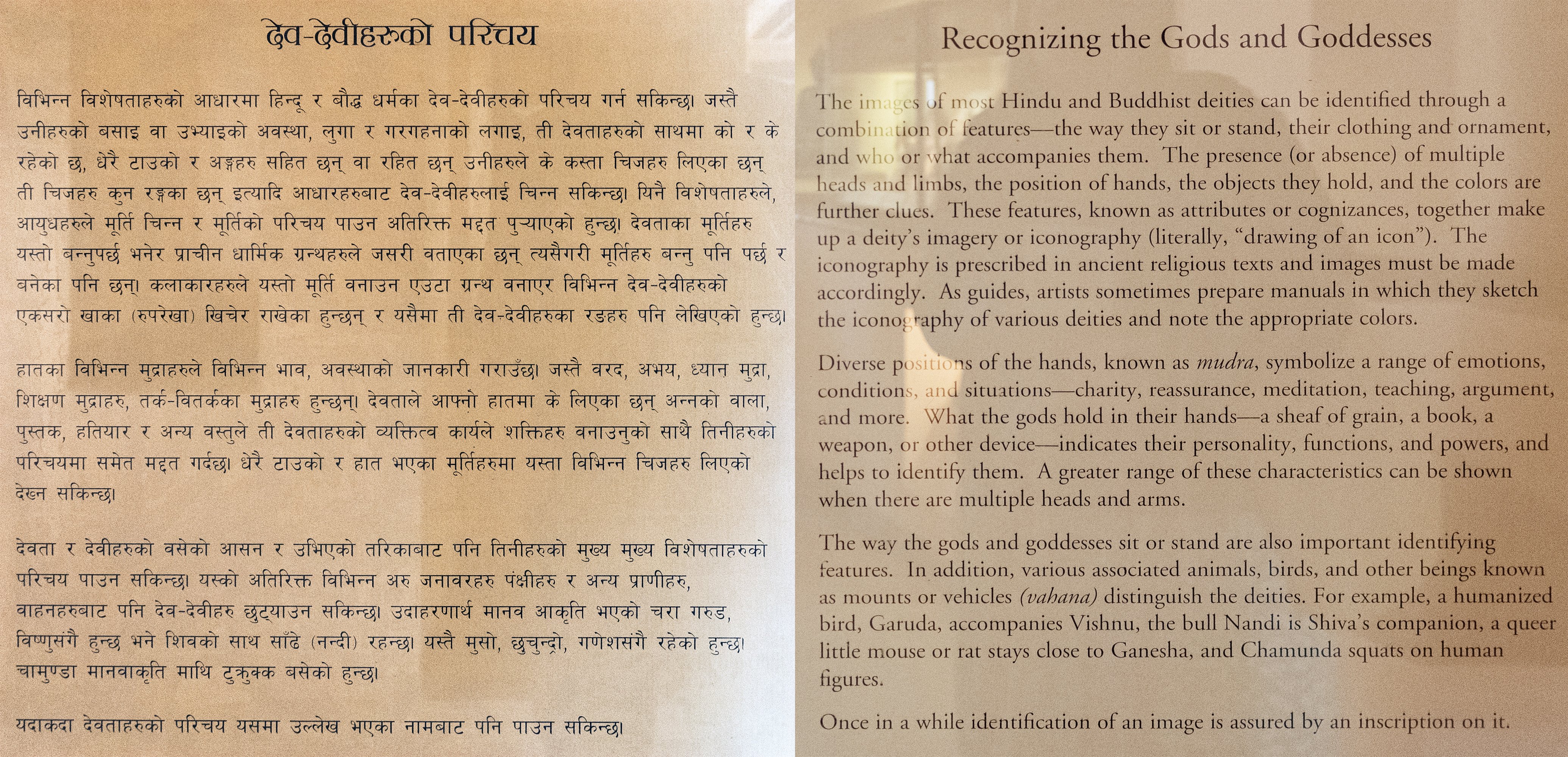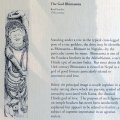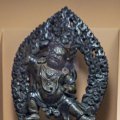Patan Museum (Nepal): photo 18
Photo 18 of 212 in Gallery: Patan Museum (Nepal)

Image title: Recognizing the Gods and Goddesses
Description of the photo
The images of most Hindu and Buddhist deities can be identified through a combination of features-the way they sit or stand, their clothing and ornament, and who or what accompanies them. The presence (or absence) of multiple heads and limbs, the position of hands, the objects they hold, and the colors are further clues. These features, known as attributes or cognizances, together make up a deity's imagery or iconography (literally, "drawing of an icon"). The iconography is prescribed in ancient religious texts and images must be made accordingly. As guides, artists sometimes prepare manuals in which they sketch the iconography of various deities and note the appropriate colors.
Diverse positions of the hands, known as mudra, symbolize a range of emotions, conditions, and situations-charity, reassurance, meditation, teaching, argument, and more. What the gods hold in their hands-a sheaf of grain, a book, a weapon, or other device-indicates their personality, functions, and powers, and helps to identify them. A greater range of these characteristics can be shown when there are multiple heads and arms.
The way the gods and goddesses sit or stand are also important identifying features. In addition, various associated animals, birds, and other beings known as mounts or vehicles (vahana) distinguish the deities. For example, a humanized bird, Garuda, accompanies Vishnu, the bull Nandi is Shiva's companion, a queer little mouse or rat stays close to Ganesha, and Chamunda squats on human figures.
Once in a while identification of an image is assured by an inscription on it.
Nepalese text (not proofread):
देवदेवीहरूको परिचय—विभिन्न विशेषताहरुको आधारमा हिन्दू र बौद्ध धर्मका देव-देवीहरुको परिचय गर्न सकिन्छ। जस्तै उनीहरुको बसाइ वा उभ्याइको अवस्था, लुगा र गरगहनाको लगाइ ती देवताहरुको साथमा को र के रहेको छ, धेरै टाउको र अङ्गहरु सहित छन् वा रहित छन् उनीहरुले के कस्ता चिजहरु लिएका छन् ती चिजहरु कुन रङ्गका छन् इत्यादि आधारहरुबाट देव-देवीहरुलाई चिन्न सकिन्छ। यिनै विशेषताहरुले, आयुधहरुले मूर्ति चिन्न र मूर्तिको परिचय पाउन अतिरिक्त मद्दत पुयाएको हुन्छ देवताका मूर्तिहरु यस्तो बन्नुपर्छ भनेर प्राचीन धार्मिक ग्रन्थहरुले जसरी बताएका छन् त्यसैगरी मूर्तिहरु बन्नु पनि पर्छ र बनेका पनि छन् । कलाकारहरुले यस्तो मूर्ति बनाउन एउटा ग्रन्थ बनाएर विभिन्न देवदेवीहरुको एकसरो खाका (रुपरेखा) खिचेर राखेका हुन्छन् र यसैमा ती देव-देवीहरुका रङहरु पनि लेखिएको हुन्छ।
हातका विभिन्न मुद्राहरुले विभिन्न भाव, अवस्थाको जानकारी गराउछा जस्तै वरद, अभय, ध्यान मुद्रा, शिक्षण मुद्राहरु, तर्क-वितर्कका मुद्राहरु हुन्छन्। देवताले आफ्नो हातमा के लिएका छन् अन्नको वाला, पुस्तक, हतियार र अन्य वस्तुले ती देवताहरुको व्यक्तित्व कार्यले शक्तिहरु बनाउनुको साथै तिनीहरुको परिचयमा समेत मद्दत गर्दछ। धेरै टाउको र हात भएका मूर्तिहरुमा यस्ता विभिन्न चिजहरु लिएको देख्न सकिन्छ ।
देवता र देवीहरुको बसेको आसन र उभिएको तरिकाबाट पनि तिनीहरुको मुख्य मुख्य विशेषताहरुको परिचय पाउन सकिन्छ। यस्को अतिरिक्त विभिन्न अरु जनावरहरु पक्षीहरु र अन्य प्राणीहरु, बाहनहरुबाट पनि देवदेवीहरु छुट्याउन सकिन्छा उदाहरणार्थ मानव आकृति भएको चरा गरुड, विष्णुसँगै हुन्छ भने शिवको साथ साढे (नन्दी) रहन्छ । यस्तै मुसो, छुचुन्द्रो, गणेशसंगै रहेको हुन्छ। चामुण्डा मानवाकृति माथि टुक्रुक्क बसेको हुन्छ
यदाकदा देवताहरुको परिचय यसमा उल्लेख भएका नामबाट पनि पाउन सकिन्छ ।
English translation (automated)
Introduction to Gods and Goddesses—Hindu and Buddhist gods and goddesses can be introduced based on various characteristics. Gods and Goddesses can be identified from the bases such as their sitting or standing position, wearing clothes and jewelry, who and what is with those gods, whether they have many heads and limbs or not, what things they are carrying, what color those things are, etc. These characteristics, weapons have provided additional help to identify the idol and to get the identity of the idol. Just as the ancient religious texts have said that idols of gods should be made like this, idols should be made and have been made. The artists make a book to make such a statue and draw a blueprint (outline) of different gods and goddesses and the colors of those gods and goddesses are also written in it.
Different hand mudras convey different feelings and states such as Varad, Abhay, Dhyana Mudras, teaching mudras, argumentative mudras. What the deities hold in their hands, such as grain bowls, books, weapons and other objects, also help in identifying the personalities of those deities, as well as creating their powers. Various things can be seen in the statues with many heads and hands.
Their main characteristics can also be found from the way they sit and stand. In addition to this, gods and goddesses can be distinguished from various other animals, birds and other animals, vehicles, for example, Garuda, a bird with a human form, is with Vishnu, while Nandi is with Shiva. Similarly Muso, Chuchundro, Ganesha are present. Chamunda sits crouched over the anthropomorphism
Sometimes the introduction of the gods can be found from the names mentioned in it.
Transcription:
devadevīharūko paricaya
vibhinna viśeṣatāharuko ādhāramā hindū ra bauddha dharmakā deva-devīharuko paricaya garna sakincha. Jastai unīharuko basāi vā ubhyāiko avasthā, lugā ra garagahanāko lagāi tī devatāharuko sāthamā ko ra ke raheko cha, dherai ṭāuko ra aṅgaharu sahita chan vā rahita chan unīharule ke kastā cijaharu liekā chan tī cijaharu kuna raṅgakā chan ityādi ādhāraharubāṭa deva-devīharulāī cinna sakincha. Yinai viśeṣatāharule, āyudhaharule mūrti cinna ra mūrtiko paricaya pāuna atirikta maddata puyāeko huncha devatākā mūrtiharu yasto bannuparcha bhanera prācīna dhārmika granthaharule jasarī batāekā chan tyasaigarī mūrtiharu bannu pani parcha ra banekā pani chan . Kalākāraharule yasto mūrti banāuna euṭā grantha banāera vibhinna devadevīharuko ekasaro khākā (ruparekhā) khicera rākhekā hunchan ra yasaimā tī deva-devīharukā raṅaharu pani lekhieko huncha.
hātakā vibhinna mudrāharule vibhinna bhāva, avasthāko jānakārī garāuchā jastai varada, abhaya, dhyāna mudrā, śikṣaṇa mudrāharu, tarka-vitarkakā mudrāharu hunchan. Devatāle āphno hātamā ke liekā chan annako vālā, pustaka, hatiyāra ra anya vastule tī devatāharuko vyaktitva kāryale śaktiharu banāunuko sāthai tinīharuko paricayamā sameta maddata gardacha. Dherai ṭāuko ra hāta bhaekā mūrtiharumā yastā vibhinna cijaharu lieko dekhna sakincha .
devatā ra devīharuko baseko āsana ra ubhieko tarikābāṭa pani tinīharuko mukhya mukhya viśeṣatāharuko paricaya pāuna sakincha. Yasko atirikta vibhinna aru janāvaraharu pakṣīharu ra anya prāṇīharu, bāhanaharubāṭa pani devadevīharu chuṭyāuna sakinchā udāharaṇārtha mānava ākṛti bhaeko carā garuḍa, viṣṇusaṃgai huncha bhane śivako sātha sāḍhe (nandī) rahancha . Yastai muso, chucundro, gaṇeśasaṃgai raheko huncha. Cāmuṇḍā mānavākṛti māthi ṭukrukka baseko huncha
yadākadā devatāharuko paricaya yasamā ullekha bhaekā nāmabāṭa pani pāuna sakincha .
Transcription:
vibhinna visheshataharuko adharama hindu ra bauddha dharmaka deva-deviharuko paricaya garna sakincha. jastai uniharuko basai va ubhyaiko avastha, luga ra garagahanako lagai ti devataharuko sathama ko ra ke raheko cha, dherai tauko ra angaharu sahita chan va rahita chan uniharule ke kasta cijaharu lieka chan ti cijaharu kuna rangaka chan ityadi adharaharubata deva-deviharulai cinna sakincha. yinai visheshataharule, ayudhaharule murti cinna ra murtiko paricaya pauna atirikta maddata puyaeko huncha devataka murtiharu yasto bannuparcha bhanera pracina dharmika granthaharule jasari bataeka chan tyasaigari murtiharu bannu pani parcha ra baneka pani chan . kalakaraharule yasto murti banauna euta grantha banaera vibhinna devadeviharuko ekasaro khaka (ruparekha) khicera rakheka hunchan ra yasaima ti deva-deviharuka ranaharu pani lekhieko huncha.
hataka vibhinna mudraharule vibhinna bhava, avasthako janakari garaucha jastai varada, abhaya, dhyana mudra, shikshana mudraharu, tarka-vitarkaka mudraharu hunchan. devatale aphno hatama ke lieka chan annako vala, pustaka, hatiyara ra anya vastule ti devataharuko vyaktitva karyale shaktiharu banaunuko sathai tiniharuko paricayama sameta maddata gardacha. dherai tauko ra hata bhaeka murtiharuma yasta vibhinna cijaharu lieko dekhna sakincha .
devata ra deviharuko baseko asana ra ubhieko tarikabata pani tiniharuko mukhya mukhya visheshataharuko paricaya pauna sakincha. yasko atirikta vibhinna aru janavaraharu pakshiharu ra anya praniharu, bahanaharubata pani devadeviharu chutyauna sakincha udaharanartha manava akriti bhaeko cara garuda, vishnusamgai huncha bhane shivako satha sadhe (nandi) rahancha . yastai muso, chucundro, ganeshasamgai raheko huncha. camunda manavakriti mathi tukrukka baseko huncha
yadakada devataharuko paricaya yasama ullekha bhaeka namabata pani pauna sakincha .
Gallery information:
The Patan Museum is located on the Durbar square of Patan (Lalitpur/Lalitapura, Kathmandu, Nepal) which is associated Keshav Narayan Chowk (Keshavnarayan)—a form of Lord Vishnu. Being listed as a World Heritage Site, the whole of Durbar square is filled with exquisite temples, sculptures and other ancient structures, of which the ancient history history can be traced to the Malla Kings of Lalitpur. It is an important site for both Buddhism and Hinduism.
Photo details:
Date: 2019-12-02
Camera: SONY ILCE-6400
Exposure: 1/20
Aperture: f/4
ISO: 1600
Focal length: 18mm
High resolution:
Download file
Size: 5.47 MB
Resolution: 4140 x 2000
© Photograph by Gabe Hiemstra.
License: CC BY-NC-ND 4.0

